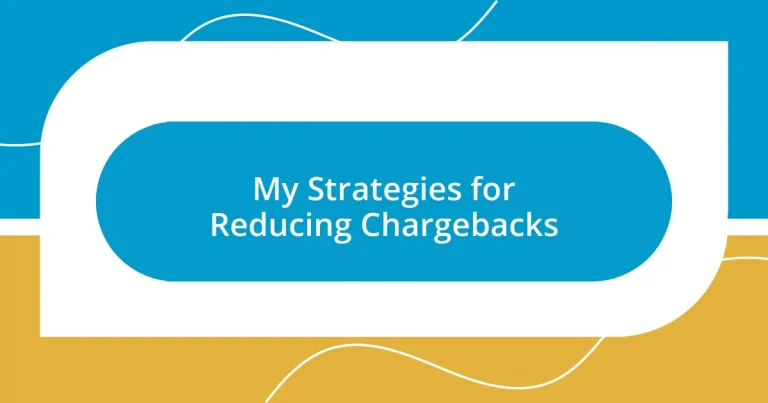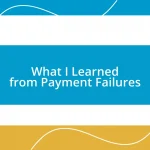Key takeaways:
- Understanding chargebacks is crucial; they often stem from fraud, dissatisfaction, or processing errors, emphasizing the need for excellent customer service and communication.
- Implementing strong payment security measures, like SSL encryption and regular transaction monitoring, enhances trust and reduces fraud-related chargebacks.
- Continuous improvement through customer feedback, regular process reviews, and employee training fosters better customer relationships and decreases chargebacks.
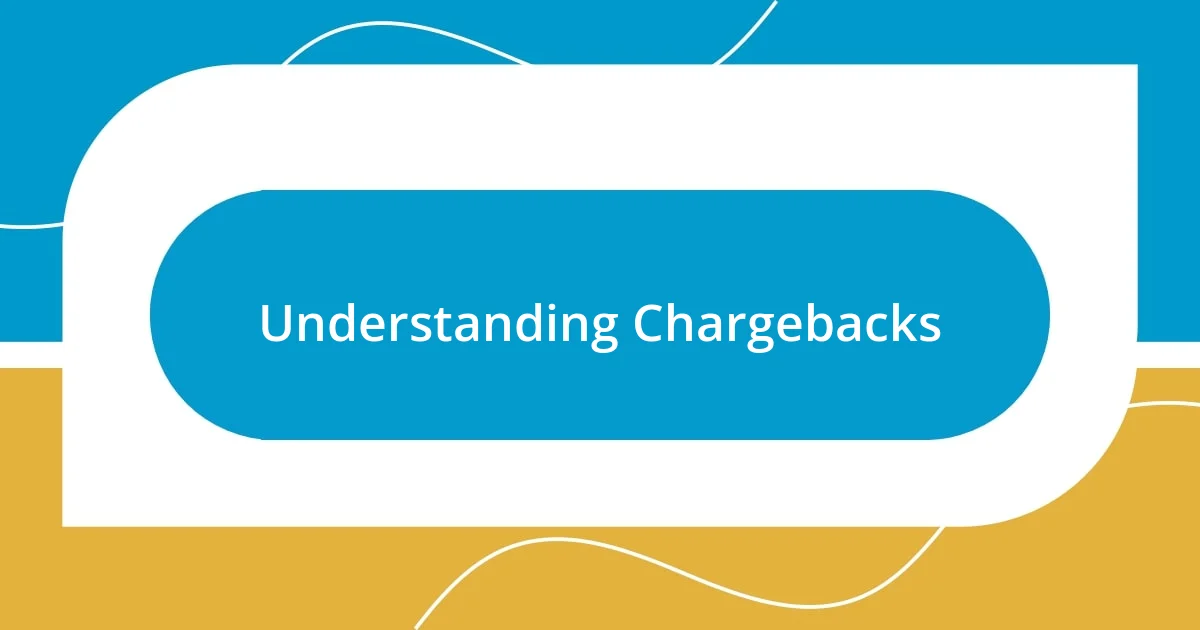
Understanding Chargebacks
Chargebacks occur when a cardholder disputes a transaction with their bank, leading to the bank reversing the charge to the merchant. I remember a time when I was shocked to receive a notification of a chargeback on my small online business. The frustration was palpable—I had invested so much effort and care into that sale, only to feel my hard work dismissed with a click.
Understanding the reasons behind chargebacks is crucial. They can arise from fraud, dissatisfaction with a service, or even errors in processing. Have you ever been in a situation where you expected a product, only to be let down? That feeling can drive someone to dispute a charge, highlighting how important it is for merchants to provide excellent service and clear communication.
The emotional impact of chargebacks can be overwhelming for business owners. Beyond the financial loss, there’s often a sense of betrayal or helplessness. Every chargeback feels like a personal affront. It makes me think—how can we create a customer experience so positive that chargebacks become an anomaly rather than the norm? Exploring this has led me to actively seek feedback from my customers, ensuring that their voices are heard before things escalate to that level.
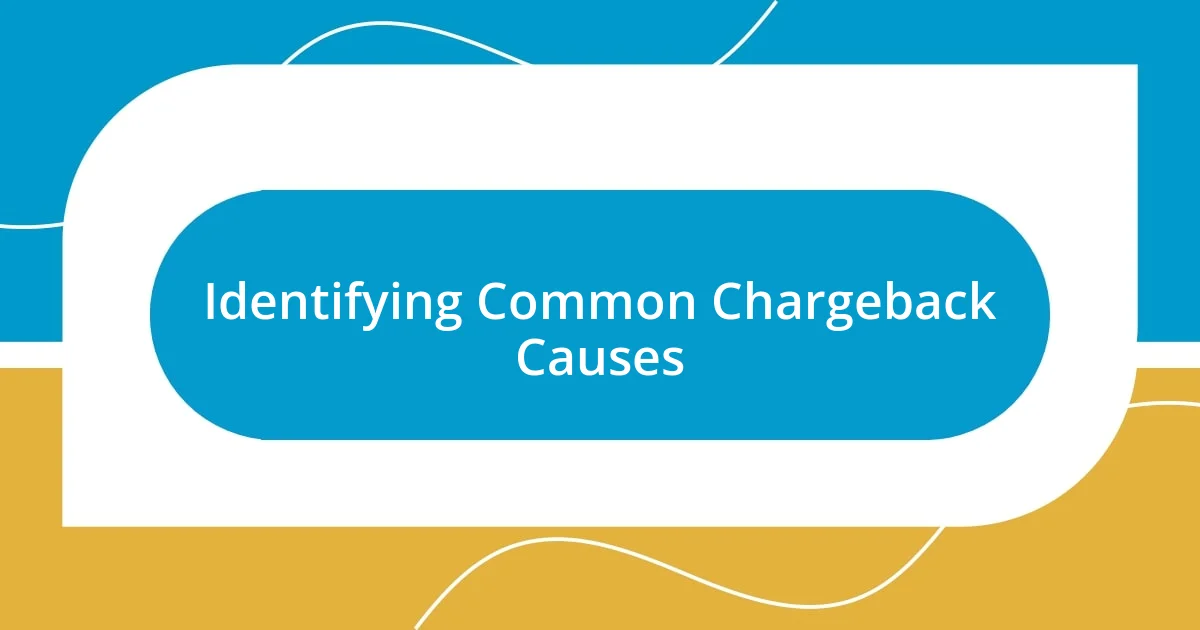
Identifying Common Chargeback Causes
Identifying the common causes of chargebacks can feel like unraveling a mystery. From my experience, one prevalent cause is fraudulent transactions. Imagine a scenario where an unsuspecting customer finds unauthorized charges on their card—that’s enough to trigger a chargeback. I remember once having to navigate this situation when someone disputed a legitimate charge on their account, which left me wondering how to safeguard my business against such deception.
Another significant cause revolves around product dissatisfaction. Whether it’s an item not meeting expectations or shipping delays, customers may resort to chargebacks when they feel let down. I recall a time when a customer was disappointed with the quality of a product—despite my efforts to provide quality service, their dissatisfaction ultimately led them to dispute the charge. It was a tough lesson in how crucial customer expectations and communication are in preventing chargebacks.
Lastly, errors in transaction processing can also lead to these frustrating situations. Mistakes such as duplicate charges or unrecognized transactions leave customers confused and angry. I once made an error where a customer was charged twice for the same order, and their frustration was palpable. This experience taught me the importance of meticulous transaction records and clarity in billing to minimize chargebacks.
| Chargeback Cause | Description |
|---|---|
| Fraudulent Transactions | Unauthorized charges that trigger disputes. |
| Product Dissatisfaction | When items fail to meet customer expectations or experience delays. |
| Processing Errors | Mistakes in billing that create confusion and lead to disputes. |
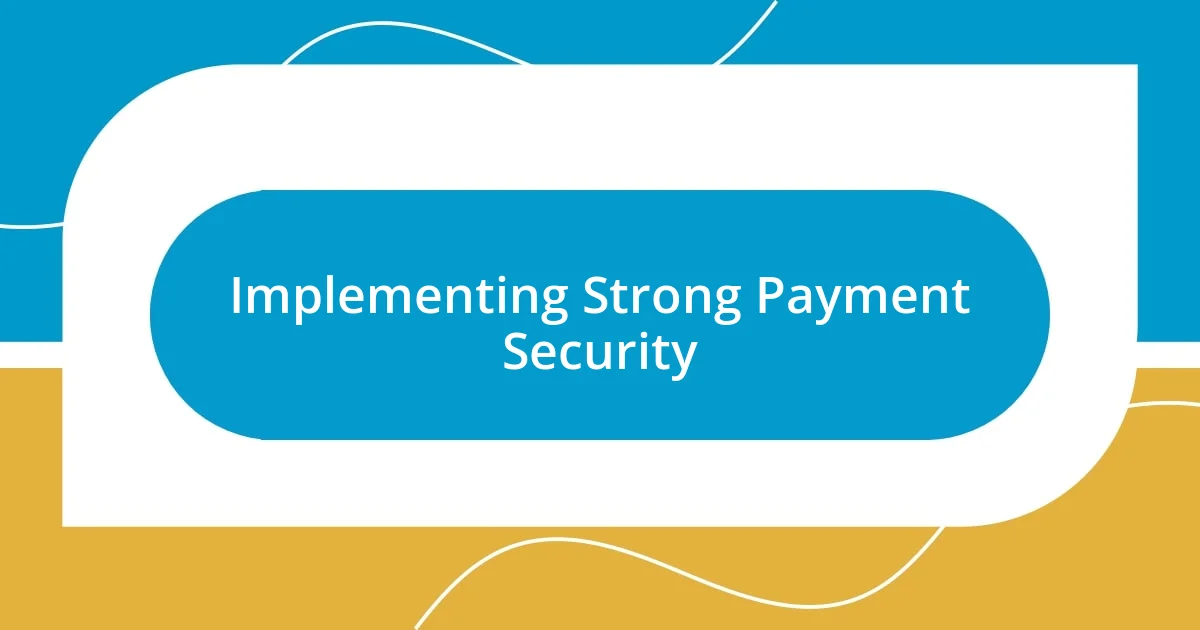
Implementing Strong Payment Security
When I think about implementing strong payment security, I cannot emphasize enough its importance in the chargeback landscape. A robust security framework is vital for building trust and preventing issues down the line. I’ve experienced firsthand how reassuring secure payment options can be for a customer. Just last month, a buyer expressed relief after I assured them that their information was encrypted and that I utilized trusted payment processors. Their comfort level increased dramatically, which can directly lead to customer loyalty.
Here are some effective strategies to enhance payment security:
- Use SSL Certificates: Encrypt data transmitted between your site and users, safeguarding sensitive payment information.
- Implement 3D Secure: This added layer of authentication helps verify the user’s identity during the transaction.
- Regularly Monitor Transactions: Keep an eye on transaction patterns to quickly identify any unusual or potentially fraudulent activity.
- Employ Advanced Fraud Detection Tools: Utilize sophisticated tools that use machine learning to detect navigation anomalies, such as multiple failed attempts to access a customer account.
- Educate Customers: Share tips with your customers about recognizing secure payment environments and the importance of maintaining their own online security.
By prioritizing these measures, I’ve managed to create a safer shopping environment and significantly reduce the potential for chargebacks due to fraud, ultimately leading to a more positive customer experience.
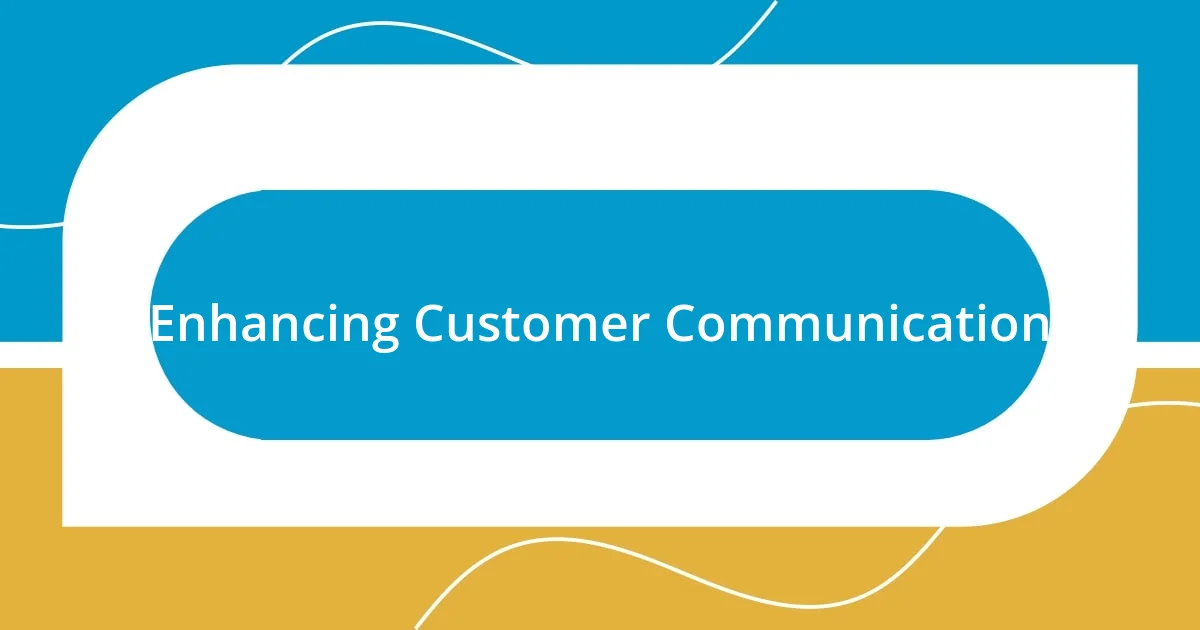
Enhancing Customer Communication
Building strong lines of communication with customers is paramount in reducing chargebacks. I’ve seen that when I proactively reach out to customers after a purchase, it not only opens up dialogue but also helps clarify any questions they might have. For instance, after implementing a follow-up email strategy, I noticed a significant drop in chargeback requests, as customers appreciated the personal touch and felt more connected to my brand.
Another aspect I’ve found effective is being transparent about my return and refund policies. One time, a customer expressed confusion about an item they received—if only I had been clearer about the process! After that, I made it a point to include a detailed FAQ section on my website. This not only empowered customers with knowledge but also built their trust. Have you ever wondered how clarity can turn a potential chargeback into a chance for brand loyalty?
Lastly, I’ve also learned the value of listening to customer feedback. When customers know that their opinions matter, they’re less likely to feel the need to dispute a charge. I recall a situation where a customer provided constructive criticism about shipping times. By addressing their concerns in real-time, I not only resolved the issue but also reinforced their confidence in my service. It’s moments like these that remind me how enhancing customer communication is a vital strategy in the ongoing battle against chargebacks.
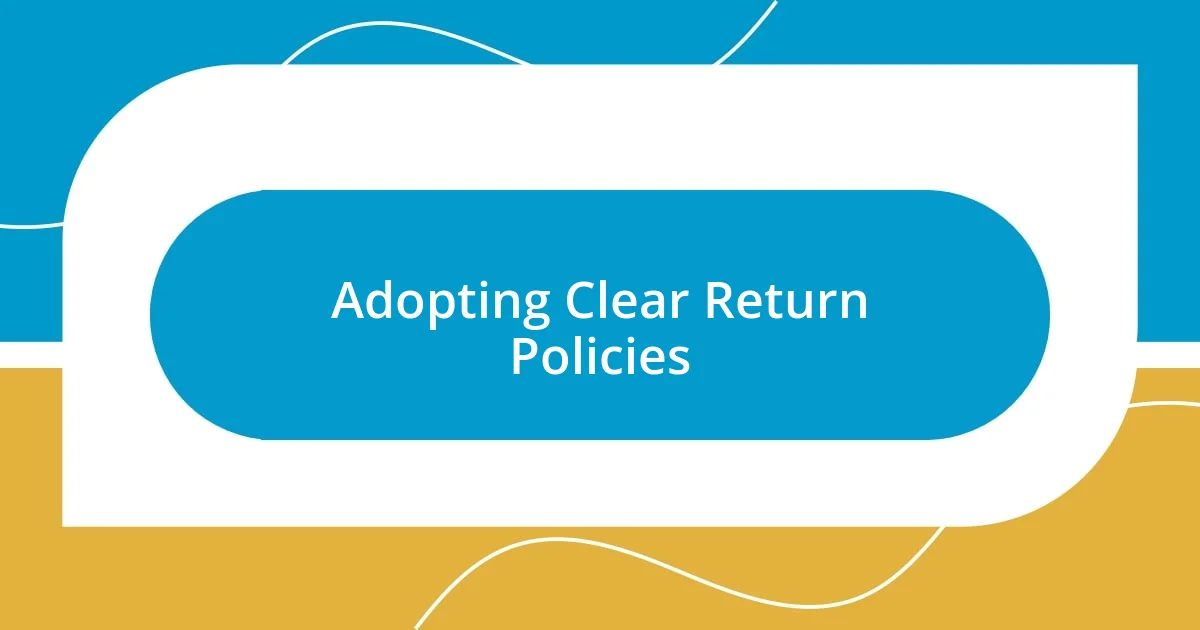
Adopting Clear Return Policies
Clarity in return policies has been a game changer for me. I remember a time when an unclear return policy led to a frustrated customer who felt lost about how to send back an item. After a lengthy dispute, the chargeback was filed, and it served as a painful reminder. Since then, I’ve made it a priority to create straightforward, concise return policies that are easy for customers to understand. When they know what to expect, it ultimately reduces their frustration and can help prevent that discord from leading to a chargeback.
I’ve also found that clearly stating the timeframe for returns is essential. There’s nothing worse than having a customer feel they missed a window simply because the policy wasn’t transparent. I once had a customer miss the deadline by just a day. They were upset, and I felt awful knowing it could have been avoided with clearer communication. Now, I not only outline the return period on the website but also include it in confirmation emails. Have you ever considered how such simple steps could make your relationship with your customers stronger? By doing this, I’ve fostered a sense of trust that encourages loyalty over disagreement.
One effective tactic that I adopted recently is the use of visuals—yes, visuals! I’ve started to integrate graphics that depict the return process step-by-step. This small addition turns what could be a tedious read into a more engaging experience. I was amazed when a customer reached out, expressing gratitude for how simple the visual made the process. Moments like this remind me that a little effort in communicating details goes a long way. The easier I make it for customers to understand how returns work, the less likely they are to feel confused or misled, ultimately reducing chargebacks.
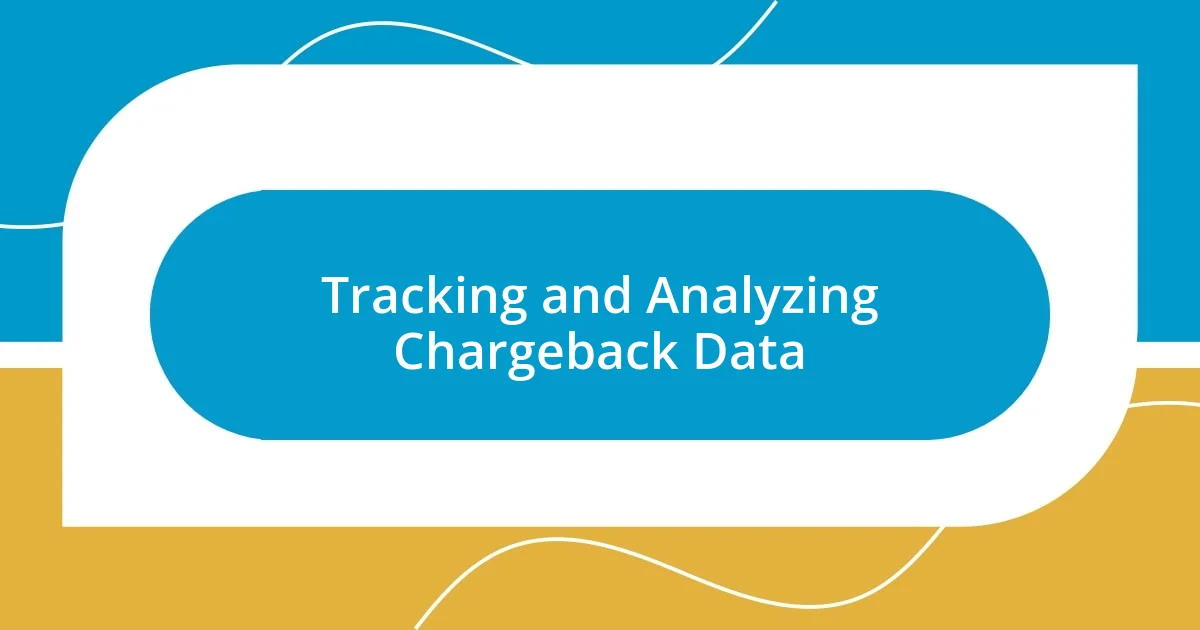
Tracking and Analyzing Chargeback Data
Tracking chargeback data has been eye-opening for me. It’s like shining a light on areas where I can improve. I recall the first time I dove into analytics; I discovered trends that I had completely overlooked. By segmenting chargeback reasons, I was able to pinpoint specific issues, such as unauthorized transactions and dissatisfaction with a product. This really emphasized the importance of knowing why customers dispute charges and showed me where I needed to focus my efforts.
Analyzing this data also revealed patterns in peak chargeback times. For example, I noticed an uptick right after holidays. This insight prompted me to ramp up customer service during those busy periods. With more eyes on potential issues, I felt more prepared to address customer concerns before they escalated into chargebacks. Have you experienced a similar scenario where data helped you anticipate challenges?
It’s crucial, too, to track not only the numbers but also the sentiments behind those disputes. I once received feedback that a customer felt misled about shipping costs, which led to their chargeback. Connecting those sentiment dots gave me a clearer understanding of the emotional aspect involved in these disputes. By approaching chargebacks as opportunities for growth and understanding, I was able to refine my practices and enhance the overall customer experience—and ultimately drive down those chargeback rates.
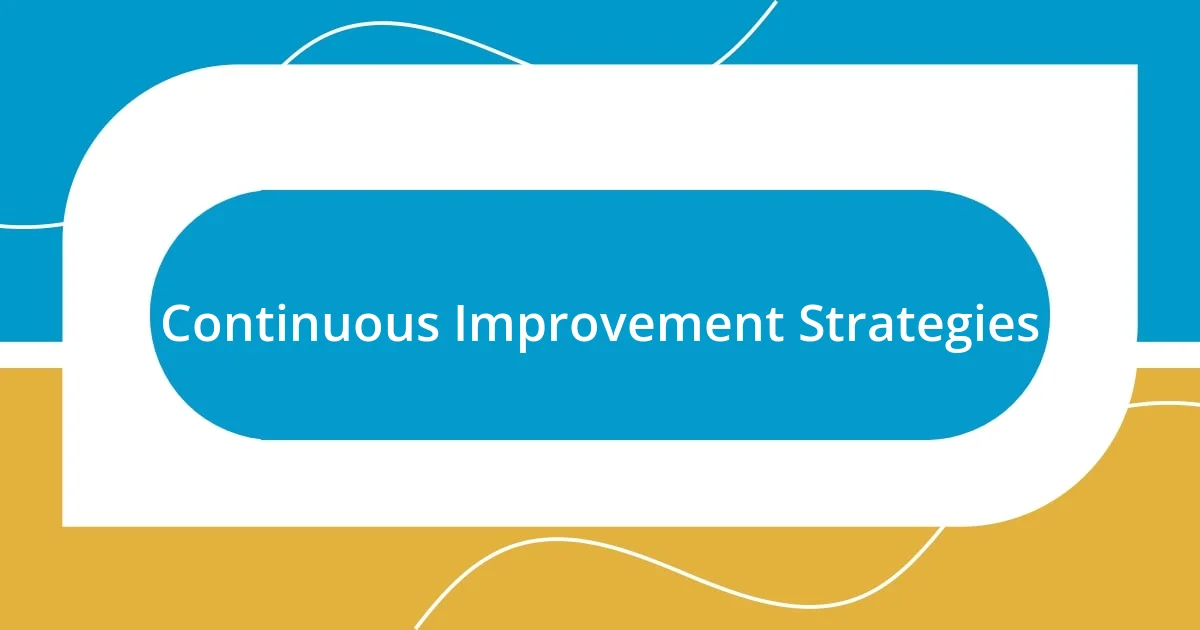
Continuous Improvement Strategies
I’ve found that adopting a culture of continuous improvement has been essential in managing chargebacks effectively. Regularly reviewing processes is something I’ve embraced wholeheartedly. For instance, I set aside time each month to assess what’s working and what isn’t. I once stumbled across an old policy that seemed fine at the time, but a fresh perspective revealed it was actually causing confusion. Engaging with my team during these reviews often sparks innovative ideas—have you ever noticed how a simple conversation can ignite a plethora of solutions?
One method that really caught my attention was the implementation of customer feedback loops. I started proactively reaching out to customers post-purchase to gather their thoughts. This not only reassured them that I value their opinions but also opened the door to address potential concerns before they escalate. I remember one customer expressing dissatisfaction that their delivery was later than expected. Had I not reached out, that frustration could have easily turned into a chargeback. By integrating these feedback channels, I’ve positioned myself to continuously refine my service while building stronger relationships.
In addition to gathering feedback, I’ve taken a deep dive into employee training. I realized that my team needed to be equipped with the right tools to handle customer interactions effectively. By conducting regular training sessions focused on communication and conflict resolution, I’ve noticed a significant improvement in our customer service approach. I often think about how a well-trained team can de-escalate situations that could lead to chargebacks—don’t you think that the way we communicate can directly influence our customer relationships? Investing in ongoing training has not only empowered my team but has also created a board of advocates for my business, which is invaluable in maintaining a positive customer experience.












